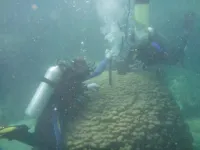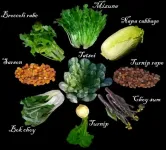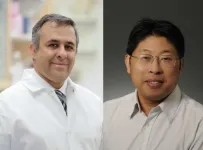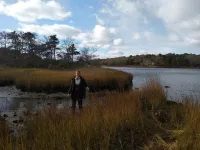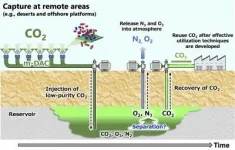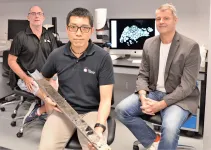Structural uniqueness of the green- and red-light sensing photosensor in cyanobacteria
2021-06-04
(Press-News.org) Overview:
Certain cyanobacteria can change the absorbing light colors for photosynthesis using a green- and red-light sensing photosensor protein. A Japanese research group elucidated the molecular structure of RcaE, a representative member of the photosensors. They revealed the unique conformation of the bilin chromophore and the unique protein structure that potentially functions as a proton transfer route to bilin. They also demonstrated that RcaE undergoes protonation and deprotonation of the bilin chromophore during the green and red photoconversion. These results provide insights into how cyanobacteria evolved photosensors with diverse spectral sensitivities and contribute to the development of new photoswitches of gene expression.
Details:
Certain cyanobacteria can utilize both green and red lights for photosynthesis by using their light-harvesting antenna supercomplex called phycobilisome. They can control the absorptive maxima of phycobilisome, which results in remarkable changes in cell color. This phenomenon is regulated by RcaE that belongs to cyanobacteriochrome family of photosensors. RcaE harbors a bilin chromophore and photoconverts green- and red-absorbing states to sense ambient light colors. Although the green and red photoconversion is involved in bilin photoisomerization and subsequent change in bilin protonation state, the structural basis of this photoconversion remains unknown.
The research group comprised Takayuki Nagae (Nagoya University), Masaki Mishima (Tokyo University of Pharmacy and Life Science), Yuu Hirose (Toyohashi University of Technology), Masashi Unno (Saga University), Kei Wada (Miyazaki University), and Yutaka Itoh (Tokyo City University). They determined the high-resolution structure of RcaE in its red-absorbing state via X-ray crystallography. The bilin chromophore showed a conformation with co-planar A-C rings, wherein the nitrogen atoms were facing inward; the nitrogen of the tilted D-ring was facing outward (classified as C15-E,syn structure). Additionally, they identified a porous cavity containing water molecules in the bilin-binding pocket of RcaE. The clustered water molecules were connected with the nitrogen atoms of bilin A-C rings by a hydrogen bond network through the conserved acidic residue, Glu217.
The research group demonstrated by molecular dynamic simulations that the water molecules in the cavity were exchanged with the solvent water. They also demonstrated by 15N NMR spectroscopy that four pyrrole nitrogen atoms of bilin are fully protonated in the red-absorbing state, whereas one nitrogen atom is deprotonated in the green-absorbing state. They assume that the unique porous cavity functioned as a proton exit or inlet pathway during the green and red photoconversion. Considering previous study reports on Raman spectroscopy of RcaE, they proposed that bilin deprotonation occurred in the B-ring nitrogen with the C15-Z,anti structure. They are currently working on the crystallization of the green-absorbing state of RcaE to confirm this model.
Elucidating the structure and spectral tuning mechanisms of RcaE provides insights into how cyanobacteria have evolved diverse cyanobacterial subfamilies to acclimate to different light environments. Green and red light-sensing cyanobacteriochromes have been utilized in synthetic biology as sophisticated photoswitches that control gene expression. Amino acid residue modification based on RcaE structure will contribute to the development of new photoswitches with desirable photosensitivities.
INFORMATION:
Reference:
Structural basis of the protochromic green/red photocycle of the chromatic acclimation sensor RcaE.
Nagae T, Unno M, Koizumi T, Miyanoiri Y, Fujisawa T, Masui K, Kamo T, Wada K, Eki T, Ito Y, Hirose Y, Mishima M. Proc Natl Acad Sci U S A. 118(20), e2024583118, (2021) doi: 10.1073/pnas.2024583118.
[Attachments] See images for this press release:
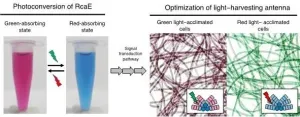
ELSE PRESS RELEASES FROM THIS DATE:
2021-06-04
Coral insights into 1,000 years of seasonal changes in the Arabian Sea warn of significant impacts caused by global warming.
Every year, the southwesterly winds of the summer monsoon sweep down the Arabian Peninsula, pushing the surface waters of the Arabian Sea away from the coast and driving an upwelling of deep waters to the surface. This rising seawater is colder and less saline than the surface water and is rich in nutrients, providing energy for the various organisms living in the Arabian Sea and Indian Ocean.
Scientists from Japan, Taiwan and Germany, including coral reef scientist Dr. Tsuyoshi Watanabe of Hokkaido University, have uncovered evidence from corals off the coast of Oman suggesting that global warming is causing changes to the Arabian Sea that could impact the ...
2021-06-04
Delicious to some, but a bitter bane to others' taste buds, vegetables like broccoli rabe, bok choy and turnips are a dinner staple ---and picky eater conflict --- around the world.
It all likely started in the mountains near present-day Afghanistan, where humans first domesticated turnips 3,500 to 6,000 years ago, according to a new study recently published in the journal Molecular Biology and Evolution. University of Wisconsin-Madison Professor of Botany Eve Emshwiller and her former graduate student Alex McAlvay (now an assistant curator assistant ...
2021-06-04
HOUSTON-(June 3, 2021) - Results were released this week on a new treatment with the potential to improve the outcomes for patients with hereditary BRCA mutations and high-risk, early-stage breast cancer. These results represent the first time a drug that blocks cancer cells from repairing their DNA (called a PARP inhibitor) has been shown to significantly reduce the risk of breast cancer returning in high-risk patients following completion of standard chemotherapy, surgery and radiation therapy.
Titled "Adjuvant Olaparib for Patients with BRCA1 or BRCA2 Mutated Breast Cancer," the paper appears in the June 3 issue of the ...
2021-06-04
Could an over-the-counter health "shot" help fight COVID-19? George Mason University researchers think it just might. ...
2021-06-04
ROCHESTER, Minn. -- A study by Mayo Clinic researchers provides some clarity in the use of direct oral anticoagulants (DOAC), such as apixaban and rivaroxaban, to treat acute venous thromboembolism (VTE) in patients with gastrointestinal cancers. The findings were published Wednesday, June 2, in Mayo Clinic Proceedings.
Among the study's findings:
Rivaroxaban showed no higher risk of bleeding in luminal gastrointestinal cancer and should not be considered contraindicated in this group of patients.
Apixaban showed a higher risk of bleeding in patients with luminal gastrointestinal cancer, and it should be used with great caution to treat this type of cancer until more studies ...
2021-06-04
WOODS HOLE, Mass. -- Plastics are everywhere. From cell phones to pens and cars to medical devices, the modern world is full of plastic-- and plastic waste. New research from scientists at the Marine Biological Laboratory (MBL) END ...
2021-06-04
A team led by UC Riverside engineers has developed a catalyst to remove a dangerous chemical from water on Earth that could also make Martian soil safer for agriculture and help produce oxygen for human Mars explorers.
Perchlorate, a negative ion consisting of one chlorine atom bonded to four oxygen atoms, occurs naturally in some soils on Earth, and is especially abundant in Martian soil. As a powerful oxidizer, perchlorate is also manufactured and used in solid rocket fuel, fireworks, munitions, airbag initiators for vehicles, matches and signal flares. It is a byproduct in some disinfectants ...
2021-06-04
Fukuoka, Japan - The global threat of ongoing climate change has one principal cause: carbon that was buried underground in the form of fossil fuels is being removed and released into the atmosphere in the form of carbon dioxide (CO2). One promising approach to addressing this problem is carbon capture and storage: using technology to take CO2 out of the atmosphere to return it underground.
In a new study published in Greenhouse Gases Science and Technology, researchers from Kyushu University and the National Institute of Advanced Industrial Science and Technology, Japan, investigated geological storage of low-purity CO2 mixed with nitrogen (N2) and oxygen (O2), produced by direct air capture (DAC) using membrane-based technology.
Many current ...
2021-06-04
Climate scientists at the Nanyang Technological University, Singapore (NTU, Singapore) have extended the known record of Singapore's sea-level to almost 10,000 years ago, providing a more robust dataset to aid future predictions of sea-level rise.
One of the main challenges in researching climate change is to reconstruct its history over thousands of years. To have a better sense of the potential causes and effects of future changes, scientists need to learn from and understand the past.
Extracting ancient sediments from a depth of up to 40 m underground at a site at Singapore's Marina South, an international team led by NTU researchers put the samples through rigorous laboratory ...
2021-06-04
Bottom Line: The majority of surveyed Americans had an inadequate understanding of palliative care, and frequency of health care utilization was one determinant of knowledge.
Journal in Which the Study was Published: Cancer Epidemiology, Biomarkers & Prevention, a journal of the American Association for Cancer Research
Author: Motolani Ogunsanya, PhD, an assistant professor at The University of Oklahoma Health Sciences Center
Background: Palliative care aims to improve the quality of life for patients and caretakers by addressing the physical, psychological, and logistical challenges associated with a disease or its treatment. In contrast to hospice, which provides comfort care for patients who have stopped treatment and are near the end of life, palliative care serves as an ...
LAST 30 PRESS RELEASES:
[Press-News.org] Structural uniqueness of the green- and red-light sensing photosensor in cyanobacteria

